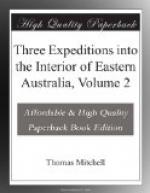Earthy deposits.
These phenomena compared with other evidence of inundation.
Salt lakes in the interior.
Changes on the seacoast.
Proofs that the coast was once higher above the sea than it is at
present.
Proofs that it was once lower.
And of violent action of the sea.
At Wollongong.
Cape Solander.
Port Jackson.
Broken Bay.
Newcastle.
Tuggerah Beach.
Bass Strait.
GEOLOGICAL SPECIMENS COLLECTED.
As any geological information respecting a country so little known as the eastern coast of Australia may be acceptable to the public, I venture to subjoin a few observations on some of the more prominent subjects of my researches, and I do so with the more confidence because it will appear how largely I am indebted for the interest they possess to the kindness of my scientific friends in England.
CONNECTION BETWEEN SOIL AND ROCKS.
During the surveys and expeditions I carefully collected specimens at every important locality, and I have thus been enabled since my return to England to mark upon my maps the geological structure of the country. By this means also I have been able to determine the relative value of the land in the districts recently explored and to compare it with that of the country previously known.
By a little attention to the geological structure of Australia we learn how much the superficial qualities of soil and productions depend upon it, and where to look for arable spots amid the general barrenness. The most intelligent surveyors of my department have on several occasions contributed considerably to my collection.
Curiosity led me to investigate some of the fossil remains of those lately discovered regions while my public duties obliged me to study also the external features of the country; and I have thus been enabled to draw some inferences respecting various changes which have taken place in the surface and in the relative level of sea and land.
The following are the principal rocks which I noticed in the country.
LIMESTONE.
Limestone occurs of different ages and quality presenting a considerable variety.
1. A light-coloured compact calcareous rock resembling mountain limestone; at Buree and Wellington, rising, at the former place, to the height of about 1500 feet above the sea.
2. A dark grey limestone appears at perhaps a still greater height on the Shoalhaven river; in immediate contact with granite.
3. A crystalline variegated marble is found in blocks a few miles westward of the above, near the Wollondilly.
4. Another variety of this rock is very abundant in the neighbourhood of Limestone plains on the interior side of the Coast ranges and near the principal sources of the Murrumbidgee. This contains corals belonging to the genus favosites; crinoideae are also found abundantly in the plains and distinguish this limestone from the others above-mentioned.




